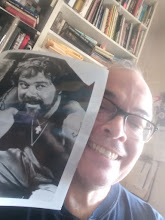

Some people don’t like to go to the doctor, even for a routine check-up. Perhaps they are expecting bad news, or have some childhood-related phobia, or just feel that the often-godlike status that is bestowed upon medical doctors is just a bit too much and that maybe these children of caduceus are even less infallible than we think.
Going to the doctor is not something that bothers me, though – honest!
And if I actually had veins that could be tapped and drained – just a little, mind you, just enough for a routine blood test, about one standard test tube’s worth – I would never be hesitant to visit the old sawbones.

But like my mother and maternal grandmother, herself a former nurse, as well as one of my colleagues at work (and perhaps millions of others worldwide), I have veins that are nearly impossible to find.
Usually the nurses – yes, plural, because after the first nurse tries, she has to call in her supervisor, and then often she has to call in the office vein specialist – try a couple of times poking around in the crook of my arm, then give up and turn to backs of my hands.
Yes, plural, because the veins on the back of my hand may be seen by the naked eye, but they sure can hide when the needle comes around.

And it is from the back of my hands, via a butterfly needle, where about 99% of my blood gets drawn - and boy! Does it sting. No lie.

For a while - a paradisiacal time I tell you - my doctor had nurse that never failed: she was so good, she’d only have to poke me maybe twice to get that test tube’s worth of my internal cherry juice. Of course, she was so good, she got a better job elsewhere. Instead of sticking with my physician for over 15 years, I should have followed her.
The needle and no damage done
This week I visited the doctor, and my veins finally beat his team. After four tries and as many nurses, they gave up, telling me to try the lab techs at the diagnostics lab.
Not that I hold this against them.
The bruises on my arm tell me their efforts were honest.

The Missus says I’m going to wind up with track marks. “Yeah,” I grumble, “without at least the sometime pleasurable benefits of becoming addicted to intravenously introduced diamorphine hydrochloride. Woo-hoo.”
 So why don’t they use those big veins on the inside of my wrists? They never seem to disappear. A nurse once told me that they were supposed to keep those veins untouched until there was a traumatic accident, like a car wreck: that if they used those veins for mundane blood tests, they might toughen up too much to be of use to emergency personnel.
So why don’t they use those big veins on the inside of my wrists? They never seem to disappear. A nurse once told me that they were supposed to keep those veins untouched until there was a traumatic accident, like a car wreck: that if they used those veins for mundane blood tests, they might toughen up too much to be of use to emergency personnel.You watch the various CSI programs on TV, where they can determine a person’s entire genetic history from a toenail clipping, and you remember that when you were a kid, the doc would use one of those small silvery rectangles with a sharp trianglular blade at the end, tap your finger, blood would ooze out and they’d collect all they needed in a thin glass pipette – and you ask yourself, so how come they need a whole test tube now?!?

If 40% of the of my day-job has this condition, why isn’t there a name for it? Under my completely autocratic control of absolutely nothing, I’ve decided to call this condition, “Hidden Vein Syndrome” – not that it’s really a “syndrome,” it’s just that “syndrome” sounds so darn cool! Even its acronym, HVS, is snappy!
But why has HVS been ignored so far? Y’know what? I need to get me some of that stimulus money the government has been throwing around and do some more research on this….
 But there is hope for me yet: Memphis, Tennessee-based Luminetx developed the VeinViewer in 2005. The device uses infrared light to project a real-time image of underlying veins directly onto a donor's skin and is reported to be a great boon to phlebotomists and nurses. Unfortunately, each unit costs about $28,000, and right now I think I’m the only one of my doctor’s patients with this problem.
But there is hope for me yet: Memphis, Tennessee-based Luminetx developed the VeinViewer in 2005. The device uses infrared light to project a real-time image of underlying veins directly onto a donor's skin and is reported to be a great boon to phlebotomists and nurses. Unfortunately, each unit costs about $28,000, and right now I think I’m the only one of my doctor’s patients with this problem.













No comments:
Post a Comment